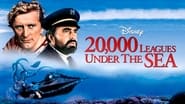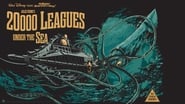cricketbat
20,000 Leagues Under the Sea holds up surprisingly well after almost 60 years. James Mason's portrayal of the eccentric Captain Nemo is both endearing and terrifying. Jules Verne's classic science fiction story is ahead of its time and I feel that this movie does it justice.
elvircorhodzic
20,000 LEAGUES UNDER THE SEA is an science fiction adventure based on the extremely popular novel. I'm a big fan of the novel by Jules Verne. The film is quite exciting and the project is extremely ambitious. I must admit I am thrilled with scenery and effects. All is the innovative and somewhat realistic. The story begins in 1868 when a scientist professor, his servant and whaler board the US Navy ship and tries to hunt down the mysterious sea monster that is in the end turns out to be a submarine. Mysterious captain captured all three of them and leads them to a long journey in undersea world.This wild and imaginative adventure is extremely picturesque. One visionary novel is a guarantor of imaginative film. I think that, despite my sincere praise, too much attention was paid to the effects. Other elements of the film suffer considerable damage. The script is still largely based on the novel. Characterization is quite weak. I am truly sorry about that, because the actors are pretty good. It's hard to believe that Peter Lorre can be tedious.James Mason as Captain Nemo is quite tough and closed character. He is alienated from the rest of the world and he suffers from leadership madness Paul Lukas as Professor Pierre Aronnax is good-natured, full of understanding with an irresistible desire for a new discovery as much as it was dangerous. Kirk Douglas as Ned Land in one ornate performance. The character who is full of life. Of course, a little outrageous humor may be counterproductive. However paired with Consiel(Peter Lorre) it looks pretty good.The finale of the film is strongly influenced by the then current Cold War and anxiety. I'm a first time watching this film in 1996., still seems pretty fresh and imaginative.
Matthew Kresal
There are films that not only stand the test of time but become icons in their own right. They are films that define a genre, sometimes without meaning to. This 1954 Disney film of Jules Verne's 20,000 Leagues Under The Sea is one such film. It is so thanks to an unlikely combination that has managed to help it pass the test of time beautifully despite the passing of more than sixty years since its original release.One of the biggest factors lies in its casting, especially of Captain Nemo. James Mason had already established his career in films like Odd Man out and The Desert Fox but it was with the role of Nemo that he earned cinematic immortality. Mason's Nemo is an incredible character: a man who is equal parts genius and haunted by a past that hinted at but never quite revealed. There's a maverick nature to Mason in the role and he plays all of these elements beautifully. Yet there's a softer, more human side to his performance where he's almost a poet laureate of the deep, such as in a scene about half-way through the film where Nemo explains why he won't share his technology. It's a wonderful performance and a measured one that rises above the potential clichés of the genre.The rest of the cast is solid, if not always up to Mason's level. There's Kirk Douglas as harpooner Ned Land in a performance that varies from comic foil to action hero, a combination that's unlikely but that works for the most part though the comic elements stand up well for a film made six decades ago. Paul Lukas as Professor Aronnax and Peter Lorre as Conseil round off the four main characters and both do decently though it's perhaps Lorre, cast against type as an academic rather than as a villain, who comes across the better of the two. With the addition of the crew of the submarine Nautilus who have a few lines here and there, it's a solid cast all around.What stands out more than even Mason's Nemo is the production design. Decades before the steampunk genre had been founded, this film established much of the feel of that genre with its design of the Nautilus both inside and out. While Verne described something that was quite akin to the modern submarine, the production design of Harper Goff came up with something that was far more cinematic that combined Victorian style with more futuristic technology. Combined with some excellent costume design for the Nautilus crew, especially the diving suits, it's something that gives the film not only one of its biggest strengths but also perhaps its most iconic element.Outside of these elements, there's plenty of other things to recommend the film for. There's the Oscar winning special effects that bring Goff's visions to life for example. Using a combination of old- school techniques including some incredibly effective model shots, the film beautifully brings to life some great moments and visuals. The effects are perfect though as can be seen in some of the back projection shots used to illustrate what characters are looking at are a bit dodgy at times. Those instances are rare and, on the whole, the effects stand up very well for a film of this age.Then there's the combination of the script by Elmer Fenton and the direction of Richard Fleischer. Anyone who has ever read the original novel will know that, by virtue of it having been written as a serial originally, it's quite episodic with little in terms of an actual plot. Fenton's script manages to bring many of the incidents from Verne's tale together while also adding new elements here and there as well as changing the occasional piece of detail such as Nemo's hinted background. With this in hand, Fleischer's direction helps to keep the film moving throughout while also adding an occasionally campy tone that sometimes works and sometimes doesn't.Elsewhere, the film shows some strong production values that illustrate some of the finest big-budget Hollywood work of the era. The cinematography for the film is fantastic throughout, highlighted perhaps by the sequences inside the Nautilus which are a sight to behold. There's also the excellently filmed underwater sequences which expertly mix together shots with doubles and inserts with the actors to bring sequences to life. The film's score by Paul Smith, while definitely a product of the era with a sound that only classic Hollywood could produce, serves the film well throughout, creating a strong sense of atmosphere from the early scenes aboard the US Navy warship the Abraham Lincoln to the underwater sequences which portray both the extreme beauty and the mystery of the deep.Nowhere though does this all of these elements come together better than in the film's signature sequence: the fight with the giant squid. Combining performances from the actors, effects ranging from model shots to a full sized attacking squid as well as practical rain and lightning, excellent cinematography and the music of Paul Smith, the results were gripping for audiences both then and now as man battles beast with not only their lives at stake but the fate of the Nautilus as well. It's something that gives the film it's best sequence as well as presenting one of the most incredible action sequences ever produced for the screen.The term "classic" can be thrown around quite easily but there's little doubt that it can be applied here. From Mason's Nemo to iconic production design that continues to influence the steampunk genre, it's a film that has become iconic in ways that Disney and his filmmakers could never have imagined. As well as remaining one of the best adaptations of a classic into a film, it also remains as watchable today as it was then. If that doesn't make this a classic, I'm not sure what does.
SimonJack
Others have given good accounts of this Disney movie based on the famous Jules Verne sci-fi novel of 1870. That Disney took on this project at all – as a real live action film instead of an animated movie, is quite a story. The restored film DVD has some bonus shorts with good background on the making of this film. The IMDb movie page has the budget estimated at $5 million. But, the cost was $2.7 million, according to the DVD bonus videos. And that was an astronomical amount for 1954. It made it the most costly film produced in the history of movies to that time – surpassing the previous most costly, "Gone With the Wind."This was a big success for Walt Disney. But it was a real gamble from the start. Before that time Disney had only done animated films. He had some great successes. But, Hollywood didn't consider him in the big leagues since he hadn't yet made a live action film. When one considers that no one in Hollywood had taken on a project like this before then, it showed Disney to be a man of action and conviction. He was already known as a dreamer and producer of fairy tales. At the time he decided to tackle "20,000 Leagues" as a live action film, he also had plans underway for the opening of Disneyland. So, this film, with its huge costs, was a "make it or break it" project for Disney. There was one silent film made before this time – by Universal in 1916. It had some underwater shots filmed in the Bahamas. But the inability to create the technical submarine and many of the underwater special effects, led the filmmakers to alter the plot considerably. It borrowed from other stories, including some other Verne fiction, and much of it was shot on dry land. With its release in 1954, Disney's "20,000 Leagues Under the Sea" did justice to the wonderful Jules Verne tale of undersea adventure, exploration and sights. The detailed, elaborate and lengthy designs of the Nautilus are most impressive and yet today give one a sense of being in a real submarine. The underwater scenes, also shot in the Bahamas, are still among the best such scenes used in movies. And the giant squid, of course, seems very real. Younger audiences today may find this classic film somewhat slow. But many aspects of it are still noteworthy and enjoyable. The set, cinematography, special effects, direction and acting all are exceptional. I doubt that the best job of CGI today could make a more realistic giant squid than the special effects crew did for this 1954 film.









